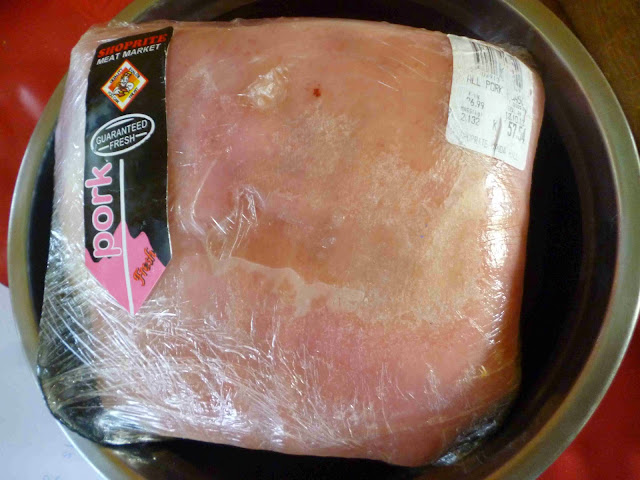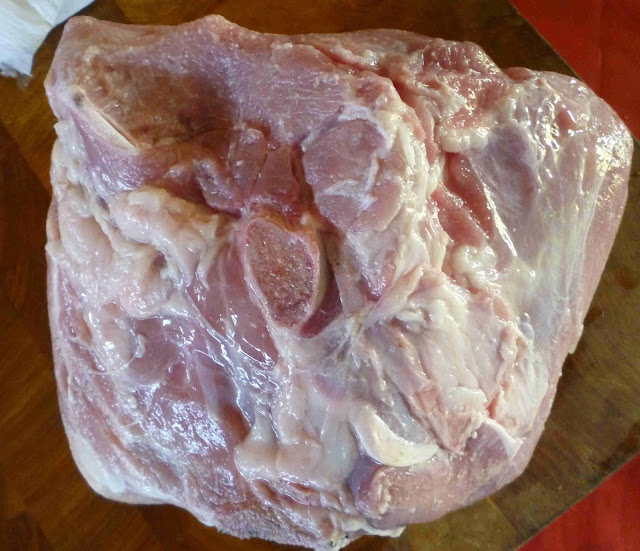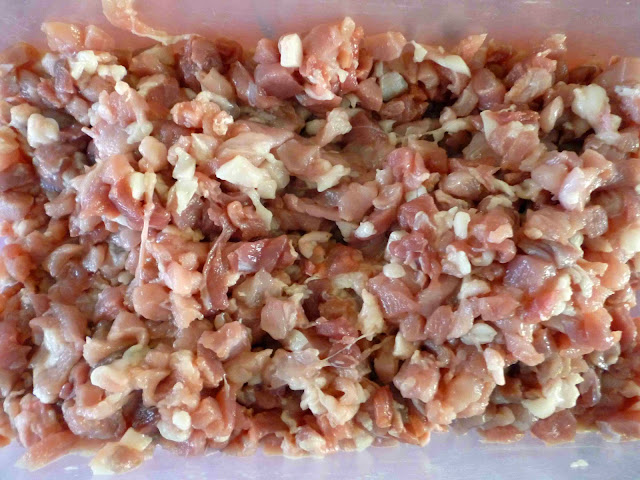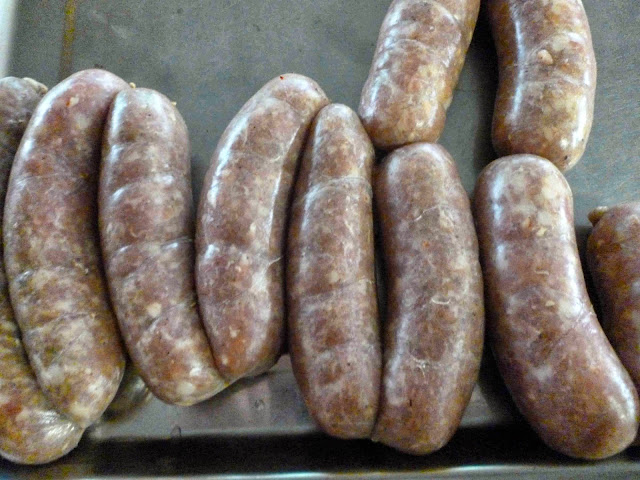RECIPE CORNER
Okay Cowboys and Wrangler Girls, it's time for BREAKFAST. Let's make some...
"Sausage Gravy Over Sourdough Biscuits"!
Let's cook up some of your "loose meat" breakfast sausage. Better yet, let's combine it with some real sourdough to make a recipe you'll always come back to!

Let the sage flavor shine through as we make a western gravy to pour over fresh biscuits. In the west (USA), our most celebrated breakfast is the most simple. We love our sausage-gravy poured over sourdough biscuits freshly made in a Dutch oven over a campfire! It doesn't get better than that! Here's the recipe and a little information to explain this stuff.
Wild Hittites, Wild Spores, Wild Beer, And... Real Sourdough!
Real Sourdough For Your Bread, Biscuits, And Pancakes
The ancient Hittites dipped unleavened flatbread into water to soften it enough to be eaten. Undoubtedly, one night after supper, some Hittite cowboy forgot to throw out the water and wild desert yeast spores (living plants of sac fungi) combined with the floury-water, feeding upon a nutritional compound of carbohydrates and glucose. In the presence of oxygen, enzymes called zymas converted the compound into carbon dioxide - the perfect bread-leavening gas for making sourdough bread. Without oxygen, the compound is converted into alcohol through the process we know as fermentation. A few days later, a Hittite horse wrangler just had to try drinking the stuff, and probably fell into his campfire. Thus, beer was born. While making sourdough bread, you will notice the pungent aroma of fermented beer. You will also recognize the wonderfully distinct and rich flavor of sourdough bread made with wild desert yeast spores. First recorded by the Egyptians, cultivated yeast as a leavening agent was probably originally developed by the Hebrews during their 430 year captivity. Involuntarily abandoned in their hasty departure from Egypt, an unpredictable substitute was provided by introducing wild desert yeast spores to a medium of spoiled buttermilk with sugar. Unrefined, this "sour" dough starter proved to be a comparatively calculable leavening, providing a reliable substitute. Hence, we have sourdough - with its natural form of leavening and distinctive fermented flavor. Producing carbon dioxide gas in a semi-predictable pattern, it has little in common with baking powder, in which the chemical reaction of an acid (cream of tartar) and an alkali (sodium bicarbonate) may deteriorate with prolonged storage.
Gluten is a compound of gliadin and glutenin proteins found in flour, giving dough it's elasticity, and the two proteins are usually found in roughly the same proportion. Containing the properties of a thickened fluid, gluten forms whenever water is mixed with flour and is able to confine and suspend carbon dioxide gas produced by activated yeast, allowing bread to rise. Gluten develops by kneading and working the dough. If it is overworked and not allowed to rest, the final product will be tough and chewy. A flaky pie crust is made of dough kneaded only a minimum number of times as compared to more substantial bread dough involving much more kneading. As you shop, compare the various gluten contents of several manufacturers` flour, and soon you will find yourself routinely selecting a preferred brand with specific gluten content for use in making sourdough. Regular supermarket bread flour has about 12 percent protein content. The flour most preferred at our ranch for use in country-style bread, contains closer to 14 percent gluten. How do you raise the gluten content? Simply add a little more water to the dough. A third cup added to a two-loaf recipe will do the trick. On the other hand, you may reduce the gluten content to 11 percent by adding a third cup less water. Whenever making sourdough bread, remember to use plain white or whole grain flour, as self-rising flour contains other leavening agents or chemicals. Although it is a good product, it is not ideal for sourdough bread making.
Gettin' "Started"
Countless articles have been written by greenhorns trying to shorten or simplify the process for making the original "San Francisco" recipe given to prospectors headed to Alaska. Don`t be fooled by simplified recipes or those using anything but buttermilk to produce a "starter". The indigenous wild yeast spores of San Francisco are legendary and most old timers will tell you, "the older the starter - the "better the batter". Sourdough starter may be purchased commercially but then...it's not from "scratch". You may make a fine starter yourself by simply mixing buttermilk and a few common ingredients. Who knows? A hundred years from now your own great-grandchildren may remember to acknowledge your own "start".
To store sourdough starter and retard its fermentation, refrigerate it. It's simple as that! Actually, the ideal inert temperature is 42 degrees F., a little higher than that of most refrigerators. The starter will activate upon gradual warming to room temperature and is then added to your favorite flour used in any recipe for biscuits, breads, or pancake batter. Unless a recipe specifies it, never allow dough to raise more than twice its size with any leavening agent as it reduces the chewy texture and alters the flavor. You may however, accelerate the production of gas bubbles by placing the bowl containing the dough over another bowl of warm water. Never raise dough on a stovetop over a warm oven as it may begin to cook. Be sure to cover the bowl with a damp towel to keep the dough moist while it is rising. Another accelerator for raising yeast dough is the addition of a little milk and sugar and a little experience will soon let you know just how much to add to a recipe. Making sourdough is not a difficult process and very much worth the effort whenever people ask how you "rustled up such tasty grub"! When the lid comes off the Dutch oven and fills the air with its distinctive aroma, they'll go crazy! Yup pards, sourdough is magic!
Ok WD wranglers, let`s get down to business. The process of making sourdough breads, biscuits, pancakes, and a variety of other "sourdough" baked goods,
consists of two parts: (1) sourdough starter and
(2) sourdough batter.
1. Sourdough
starter is made by mixing:
1 cup of water
1 tblspn. sugar
1 cup flour
4 tblspns. buttermilk
Use buttermilk only as other milk just will not make the magic. Mix the ingredients together inside a glass or stainless steel bowl, cover it with a damp towel, and then store it four or five days in a warm area. As the starter ferments, you will smell that wonderfully familiar sourdough aroma and will know when it is ready.
2. Sourdough
batter is made ten or twelve hours before baking by:
√ removing the starter from the refrigerator and allowing it to slowly warm up to room
temperature,
√ measuring out 1-1/2 cups of starter and placing it into a bowl,
√ adding 1-1/2 cups of flour and 1 cup of tepid water, and
mixing the batter well, and
√ replacing the starter used in the recipe, by stirring additional flour and water into the
remaining original starter, maintaining its volume, finally placing it back into the
refrigerator.
Old sourdoughs say each time you make bread, you must "take a little and add a little". They are, of course, referring to the starter. Use the sourdough batter mixture in recipes as called for, to make sourdough biscuits, breads, and other favorites. Return the remainder to the bowl. That's it! Now you know the secrets of making sourdough. Remember to use only tepid water at about 110 degrees F. as higher temperatures will kill the living bacteria in the yeast and the bread will not rise.
"Cowboy's Classic Sourdough Bread"
(Tried And True Classic Sourdough Bread)
2 cups proofed sourdough batter (see instructions)
1 pkg. dry yeast
1cup tepid water (110 degrees F.)
3-1/2 tspns. sugar
1 tspn. salt
6-1/2 cups all-purpose flour
1/2 can of "lager" beer
Dissolve the salt in 1/3 cup of the water and reserve it. Check the expiration date on the yeast and dissolve it in the remaining water and beer. Add the sugar and allow it to proof ten minutes. Next, add the salt solution, flour, and sourdough batter and make dough. Knead the dough until it becomes smooth and elastic. Place the dough into a glass bowl and cover it with a dampened towel or plastic wrap, allowing it to double in volume in about 60 minutes. Punch the dough down, cover it in the bowl, and allow it to rise again in about 45 minutes. Having punched the dough down for the second time, shape round loaves using a bowl or basket lined with a lightly floured clean cotton cloth. Use a flour sifter to create a light, even sprinkling of flour over the entire surface of the dough. Always cover loaves with a dishtowel or plastic wrap to avoid the formation of a dried pellicle. Allow the loaves to rise again at least forty-five minutes.
Bake the loaves inside a couple of Dutch camp ovens or place them onto a floured baking sheet in the upper half of a pre-heated kitchen oven. Place a small, shallow, pan of hot water into the bottom of the oven to help produce a crust with steam. You may also wish to sprinkle buttered loaves with sesame or poppy seeds. Bake the bread at 375 degrees F. for 35 minutes or until a golden brown crust forms.
A few sourdough tricks include the use of half water and half evaporated milk (not condensed milk which contains 40% more sweetener) in the recipe for a very smooth consistency of texture. If you wish to make bread more moist for sandwiches, add a teaspoon of olive oil to the ingredients. I also like to add an egg once in a while just to give it a special texture. It will be difficult, but you really should allow the bread to cool ten minutes before slicing it.
"Saddle Bum`s Sourdough Rye Ranch Bread"
(Hearty Sourdough Rye Sandwich Bread)
Rye, usually mixed with other types of flour, adds incredible depth and flavor to baked goods including rye bread, pumpernickel, rye crackers, and of course, sourdough rye breads and biscuits! Rye`s robust cereal grain, though not as sturdy as barley, produces flour with lower gluten content than wheat flour, yet contains a higher proportion of soluble fiber. Often used for hay, rye grass is more tolerant of acidic soil, cool weather, and dry conditions, than wheat. Rye grain is also the principal base of mash used in making rye whiskey, rye beer, and some vodka. In the old west, a shot of rye whiskey was called a "jack of diamonds". A "bar dog" (bar tender) hearing the words "rebel soldier" (rye whiskey) "wearing overalls" (double shot) would serve the customer two shot glasses and leave the bottle.
If you happen to enjoy the flavor of rye with sourdough as much as we do in the Rockies, make this hearty sourdough bread that you may dip n` dunk in less polite company. Try it with thick and delicious vegetable beef soup "fixins", or your ranch-style "meaty moooligan" stewin` "doin`s".
2 cups wheat bran
2 cups dark rye flour
3-1/2 cups white unbleached flour
2 cups proofed sourdough batter
6-1/2 cups all-purpose flour
2 pkg. dry yeast
1 can lager beer
1/2 cup molasses
2 tspns. kosher salt
2 tblspns olive oil
2 cups tepid water (110 degrees F.)
1 cup warm evaporated (not condensed) milk
butter to rub onto finished loaves
sesame or poppy seeds
Dissolve the salt into 1/3 cup of the water and reserve it. Dissolve the yeast inside a glass bowl with half the remaining water, add the milk, beer, and the molasses allowing the mixture to proof ten minutes. Mix the bran, flour, rye, olive oil, sourdough batter, and the salt solution together, forming sticky dough. Knead the dough several minutes, adding a little flour if necessary.
Cover the bowl with a dampened towel, allowing the dough to raise in about 60 minutes or until it doubles in size. Sprinkle the dough with flour then punch it down, allowing it to rise again in about 45 minutes. Punch the dough down again, cut it in half, and shape it into loaves, lightly diagonally slicing the tops three times each. Place the loaves upon floured baking sheets or inside Dutch camp ovens if you're on the trail, and allow them to rise again. Now, brush on some butter and sprinkle the loaves with toasted sesame or poppy seeds.
Place the loaves into the upper half of a pre-heated kitchen oven and add a small pan of hot water to help produce crispy crusts. Bake the bread 35 minutes or more, at 375 degrees F., until golden brown crusts form. If you wish to have slightly more moist bread for sandwiches, add another teaspoon of olive oil to the ingredients. Allow the bread to cool ten minutes before slicing it. Please try this recipe using a Dutch oven over the hot coals of your campfire following your next cattle-rustlin' job or whitewater canoe-trip.
"Shuttle Bucket Sourdough Biscuits n`Gravy"
(Soda-Raised Sourdough Biscuits With Gravy)
Biscuits:
2 cups sourdough batter
2-1/4 cups flour
1 tblspn. baking powder
1/2 tspn. baking soda
1/2 tspn. salt
1/4 cup butter (or shortening)
1/2-cup milk or buttermilk.
Prepare the batter the night before baking. Mix the dry ingredients with the butter (or shortening) until it is "grainy". Stir in the milk, batter, and salt. Knead the dough for 30 seconds only, roll it out to 1/2" thickness, and cut out 3" circles (easily done with the floured rim of a drinking glass). Coat the bottom of a pre-heated black skillet with two tablespoons of butter and dip the dough circles into it, turning them over to bake at 400 degrees F., for 15 minutes or until they are golden brown.
Gravy:
8 ounces breakfast sausage
2 tblspns. shortening
3 tblspns. flour
1- 3/4 cups milk
1/2 tspn. celery salt
salt and pepper to taste
dash cayenne pepper
Cook the sausage in a medium black skillet over medium-low heat, stirring and breaking up the ground meat with a spatula. Remove the browned crumbled sausage temporarily while you melt the shortening in the drippings inside the skillet. Add the flour, cooking it as you stir to create a roux paste. Add the milk to the roux and heat the mixture until it thickens. Return the sausage to the mixture, season it, and serve it over hot split and buttered Shuttle Bucket Sourdough Biscuits.
Storing, Freezing, And Thawing Bread
The reason bread becomes stale is not moisture loss, rather it`s caused by process called retro gradation, in which starch molecules in bread crystallize. Retro gradation in bread occurs about six times more quickly at refrigerator temperatures (36-40 degrees) than at room temperature, thereby making the refrigerator the worst choice for storing bread. However, retro gradation slows down significantly when bread is stored below freezing temperatures. Store bread at room temperature up to three days in a container that minimizes moisture loss. After three days, wrap bread tightly in foil, place it inside a freezer bag, and freeze it.
Since cold temperatures accelerate retro gradation, it is only logical that the process would be reversed by heat. Right? Anyone who has ever softened stale bread in an oven or microwave has witnessed retro gradation reversal. Ovens don`t add moisture, yet whenever stale bread (with crystallized starch) is heated to temperatures beyond 140 degrees (the gelation temperature of wheat starch), the crystals break down as their molecules form gel, softening the bread. Thaw full or partial loaves still wrapped in foil, inside a 450-degree oven for 10 or 15 minutes, then crisp the bread by removing the foil and returning it to the oven for a minute or two.









